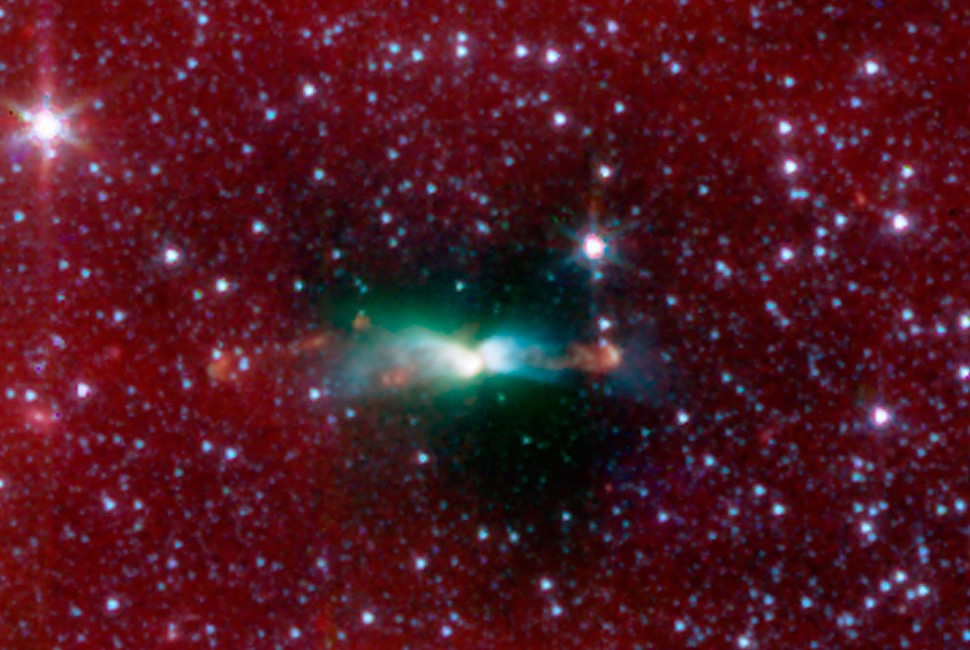From a very distant or zoomed-out point of view, stellar-forming region cloud L483 appears fine. However, when the Northwestern University team of astrophysicists zoomed more on stellar cloud L843, what they find out just became more interesting. Researchers notice that L483’s magnetic field was twisted and further discovers a hidden star cover behind a newborn star within the cloud.
Erin Cox who led the new study and is a postdoctoral associate at Northwestern’s CIERA (Center for Interdisciplinary Exploration and Research in Astrophysics) said” it’s the star’s sibling, basically”.” We think these stars formed far away, and one moved closer to the other to form a binary. When the star traveled closer to its sibling, it shifted the dynamics of the clouds to twist its magnetic fields.
Stellar nurseries are interstellar clouds of gas and dust that are collapsed by gravity to form stars, they project outflows of star material at hypersonic speeds. A magnetic field surrounding a star-forming cloud is usually parallel to these outflows. This was detected and matches the typical info of a stellar nursery when Cox and her collaborators observed the big-scale L483 cloud. But when examined using NASA”s Stratospheric for Infrared Astronomy (SOFIA), they discovered that the magnetic field is not parallel and is twisted at a 45-degree angle with respect to the outflows.
According to Erin Cox, she stated ” if you have a magnetized collapse, then the magnetic field is controlling how the star is forming. We expected to see this parallelism. But theory can say one thing, and observation can say another.
Though more observations are needed, Erin Cox thinks a previously hidden star may be the cause of the twisted 45-degree angle of cloud L 483’s magnetic field. Using SOFIA, the team discovers a newborn star-forming inside an envelope of material. the team also spotted a second star inside the same stellar envelope using radio telescopes at Atacama Large Millimeter/submillimeter Array in Chile.
Nearly the same distance apart as from our Sun to Pluto, two young stars form a binary system. In general, astrophysicists agree that binaries can be created when stellar forming regions are big enough to create two stars or when the disc rotating around a young star partially breaks up to form a star. Cox suspects that something unusual is going on with the two stars. According to Cox, the new study suggests that it’s possible for two stars to form far away from each other and one of the stars migrates closer to form a binary star system. Cox and her team don’t know why one star would move closer to another star but thinks that the movement of one of the stars shifted the dynamics of the cloud to twist the magnetic field.

Image Credit: NASA/JPL-Caltech/J. Tobin (University of Michigan)

How far away?
You’ve written terrific content on this topic, which goes to show how knowledgable you are on this subject. I happen to cover about Airport Transfer on my personal blog UY4 and would appreciate some feedback. Thank you and keep posting good stuff!
stromectol for humans – buy generic candesartan online order tegretol generic
order absorica pills – order zyvox 600 mg sale zyvox 600mg without prescription
purchase amoxicillin online cheap – amoxil us ipratropium ca
purchase zithromax online – nebivolol 20mg uk bystolic 20mg drug
prednisolone 5mg pill – buy omnacortil 5mg generic order progesterone 100mg generic
buy gabapentin pills for sale – order itraconazole sale buy sporanox pills for sale
furosemide 100mg pill – buy lasix cost betnovate 20 gm
buy clavulanate for sale – buy cymbalta 20mg generic brand cymbalta 40mg
buy generic clavulanate – nizoral oral buy cymbalta 40mg online cheap
semaglutide tablet – buy vardenafil 10mg pills buy cyproheptadine 4 mg online
tizanidine 2mg ca – buy hydrochlorothiazide 25 mg online cheap buy hydrochlorothiazide
generic cialis online – buy sildenafil 100mg generic viagra 100mg ca
buy generic sildenafil 50mg – order viagra 100mg tadalafil 20mg without prescription
cenforce 100mg generic – order chloroquine order generic metformin 1000mg
buy prilosec without prescription – buy metoprolol 100mg pill atenolol tablet
medrol 4 mg for sale – generic medrol triamcinolone 10mg sale
cytotec buy online – buy generic diltiazem for sale buy diltiazem paypal
acyclovir 800mg price – purchase zyloprim without prescription where can i buy rosuvastatin
buy motilium 10mg pills – buy cyclobenzaprine for sale buy flexeril cheap
order inderal pills – order clopidogrel 75mg pill buy methotrexate medication
warfarin medication – buy generic hyzaar cozaar ca
buy levofloxacin tablets – ranitidine 150mg brand zantac for sale
buy mobic tablets – order celebrex 200mg generic order flomax 0.4mg sale